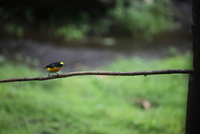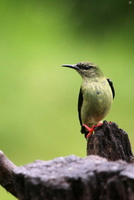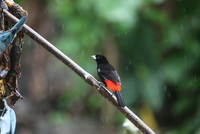Home
Photos
Hiking
Writings
Contact
Copyright
Favorites
by Subject
Chronological
David Albeck's Photos of Passeriformes
Animalia > Aves > Passeriformes
Perching birds: three toes forward, one toe back, and a special tendon to keep the foot clamped even while sleeping.
This is the largest Order of birds, and includes all the familiar songbirds.
Passeriformes: Family Index
Click a thumbnail to skip to photos of the bird family indicated
Cardinals (Cardinalidae)
Animalia > Aves > Passeriformes > Cardinalidae
A family of medium-sized, thick-billed, seed-eating birds. Includes a few "grosbeaks", "finches" and "buntings", though those names are also used for other families.
Rose-Breasted Grosbeak
Pheucticus ludovicianus

Northern Cardinal (female)

Northern Cardinal (female)
Cardinalis cardinalis

Northern Cardinal
Cardinalis cardinalis

Northern Cardinal
Cardinalis cardinalis

Northern Cardinal
Cardinalis cardinalis

Northern Cardinal
Cardinalis cardinalis

Crows & Jays (Corvidae)
Animalia > Aves > Passeriformes > Corvidae
Family Corvidae includes crows, ravens, choughs, rooks, jackdaws, jays, magpies, treepies, and nutcrackers.
Generally large birds (by songbird standards), corvids are often loud, unafraid of humans, and aggressive toward other birds and toward potential predators. Many will take food from humans (whether offered freely or not), and some also steal shiny objects. Some species are highly social, others are territorial, and some guard a feeding territory during the day but join a communal roost at night.
Corvid species are frequently mentioned among the most intelligent birds, having demonstrated self-recognition, tool-making, and problem-solving abilities. A recent study demonstrated that crows can recognize individual human faces, but I am unaware of any human ever being able to recognize an individual crow (unless the crow had a scar or similar marking).
A surefire way to identify a corvid is to look closely at the top of its beak: corvids have bristly feathers that extend forward over their nostrils. To varying degrees, corvids also all have sturdy beaks, a harsh, dissonant voice (though some are good mimics), and a tendency to walk, not hop, when on the ground.
Common Magpie
Pica pica

Blue Jay
Cyanocitta cristata

Grey Jay,
Perisoreus canadensis

Grey Jay,
Perisoreus canadensis

Grey Jay

Grey Jay,
Perisoreus canadensis

Grey Jay,
Perisoreus canadensis

Grey Jay,
Perisoreus canadensis

Steller's Jay,
Cyanocitta stelleri

Steller's Jay,
Cyanocitta stelleri

American Sparrows (Emberizidae)
Animalia > Aves > Passeriformes > Emberizidae
Small songbirds that often look like, but are not related to, Old World sparrows.
Chipping Sparrow

Dark-Eyed Junco

Savannah Sparrow
Passerculus sandwichensis

Song Sparrow
Melospiza melodia

(no gallery)
Song Sparrow

(no gallery)
Song Sparrow

(no gallery)
Song Sparrow
Melospiza melodia

Song Sparrow
Melospiza melodia

Rufous-Collared Sparrow
Zonotrichia capensis

White-Throated Sparrow
Zonotrichia albicollis

Weaver-Finches (Estrildidae)
Animalia > Aves > Passeriformes > Estrildidae
A family of small birds with very thick, short bills for cracking seeds. Their nests are roofed over.
Zebra Finch
Taeniopygia guttata
(female)

Shaft-tail Finch
Poephila acuticauda

Shaft-tail Finch
Poephila acuticauda

Owl Finch
Taeniopygia bichenovii

Three-colored parrot-Finch
Erythrura tricolor

Gouldian Finch
Erythrura gouldiae

Gouldian Finch
Erythrura gouldiae

Gouldian Finch
Erythrura gouldiae

Gouldian Finch
Erythrura gouldiae

True Finches (Fringillidae)
Animalia > Aves > Passeriformes > Fringillidae
Thick-Billed Euphonia
Euphonia laniirostris

American Goldfinch
Spinus tristis

(no album)
Orioles, Grackles, & Blackbirds (Icteridae)
Animalia > Aves > Passeriformes > Icteridae
A group of medium-size, mostly-black (the males that is), loud songbirds. Note that not all "blackbirds" are related.
Red-Winged Blackbird
(female)
Agelaius phoeniceus

Red-Winged Blackbird
(male)
Agelaius phoeniceus

Red-Winged Blackbird
(male)
Agelaius phoeniceus

Red-Winged Blackbird
(male)
Agelaius phoeniceus

Melodious Blackbird
Dives dives

Brown-headed Cowbird
(female)
Molothrus ater

(no album)
Brown-headed Cowbird
(male)
Molothrus ater

Boat-Tailed Grackle

Boat-Tailed Grackle
(male)
Quiscalus major

Boat-Tailed Grackle
(female)
Quiscalus major

Boat-Tailed Grackle
(male)
Quiscalus major

Boat-Tailed Grackle
(male)
Quiscalus major

Boat-Tailed Grackle
(male)
Quiscalus major

Great-Tailed Grackle
(female)
Quiscalus mexicanus

Common Grackle
(male)
Quiscalus quiscula

Shrikes (Laniidae)
Animalia > Aves > Passeriformes > Laniidae
Predatory birds known for keeping a meal for later by impaling it on a thorn.
Loggerhead Shrike

Loggerhead Shrike

Loggerhead Shrike
Lanius ludovicianus

Mockingbirds & Thrashers (Mimidae)
Animalia > Aves > Passeriformes > Mimidae
Medium-sized, long-tailed birds, some of which have a habit of imitating the songs of other birds, and any other sounds they hear.
Tropical Mockingbird
Mimus gilvus

Northern Mockingbird

Northern Mockingbird

Northern Mockingbird
Mimus polyglottus

Northern Mockingbird

Grey Catbird
Dumetella carolinensis

Wagtails & Pipits (Motacillidae)
Animalia > Aves > Passeriformes > Motacillidae
Meadow Pipit
Anthus pratensis

"Old World" Flycatchers (Muscicapidae)
Animalia > Aves > Passeriformes > Muscicapidae
Flycatchers native to Europe, Asia, or Africa.
White-rumped Shama

Tits, Chickadees & Titmice (Paridae)
Animalia > Aves > Passeriformes > Paridae
Small birds, often grey-backed, generally with short, thin bills. In the Americas we have "chickadees" and "titmice"; in the rest of the world, birds in this family are called "tits".
Black-Capped Chickadee

Black-Capped Chickadee

Black-Capped Chickadee
Poecile atricapillus

Black-Capped Chickadee
Poecile atricapillus

Wood-Warblers (Parulidae)
Animalia > Aves > Passeriformes > Parulidae
Small birds, often yellow, with thin bills for catching insects. Often called simply "warblers", but not related to Old World warblers.
Black-and-White Warbler
Mniotilta varia
(male)

Black-and-White Warbler
Mniotilta varia
(male)

Yellow-Rumped ("Myrtle") Warbler
Setophaga coronata

(no album)
Yellow-Rumped ("Myrtle") Warbler
Setophaga coronata

(no album)
Palm Warbler
Dendroica palmarum

Palm Warbler

Palm Warbler
Dendroica palmarum

True Sparrows (Passeridae)
Animalia > Aves > Passeriformes > Passeridae
These are the "true sparrows" because these are the ones first described by European biologists. Settlers in the Americas found similar-looking birds (emberizids) which they also called "sparrows"; but those are unrelated.
Eurasian Tree Sparrow
Passer montanus

House Sparrow (male)
Passer domesticus

House Sparrow (male)
Passer domesticus

House Sparrow (male)
Passer domesticus

House Sparrow (male)
Passer domesticus

House Sparrow (female)
Passer domesticus

House Sparrow (female)
Passer domesticus

House Sparrow (female)
Passer domesticus

House Sparrows (female)
Passer domesticus

House Sparrow (female)

(no gallery)
Kinglets (Regulidae)
Animalia > Aves > Passeriformes > Regulidae
Golden-Crowned Kinglet

(no album)
Golden-Crowned Kinglet
Regulus satrapa

(no album)
Nuthatches (Sittidae)
Animalia > Aves > Passeriformes > Sittidae
White-Breasted Nuthatch
Sitta carolinensis

Starlings & Mynahs (Sturnidae)
Animalia > Aves > Passeriformes > Sturnidae
Common Starling
Sturnus vulgaris

Common Myna
Acridotheres tristis

Tanagers (Thraupidae)
Animalia > Aves > Passeriformes > Thraupidae
A very large family of often colorful birds found throughout the Americas. Many have thick bills for eating seeds, but others eat insects or nectar. This was therefore a particularly difficult group for traditional taxonomists, and the group has undergone considerable revision in the light of genetic testing. Notably, Darwin's Galapagos "finches" are actually tanagers.
Green Honeycreeper
Chlorophanes spiza (male)

Green Honeycreeper
Chlorophanes spiza (female)

Red-Legged Honeycreeper (non-breeding male)
Cyanerpes cyaneus

Red-Legged Honeycreeper

Red-Legged Honeycreeper (female)
Cyanerpes cyaneus

"Red-Crested Cardinal"
Paroaria coronata

Passerini's Tanager
Ramphocelus passerinii (male)

Passerini's Tanager
Ramphocelus passerinii (male)

Passerini's Tanager
Ramphocelus passerinii (female)

Crimson-Collared Tanager
Ramphocelus sanguinolentus

Buff-Throated Saltator
Saltator maximus

Golden-Hooded Tanager
Tangara larvata

Blue-Gray Tanager
Thraupis episcopus

Blue-Gray Tanager
Thraupis episcopus

Palm Tanagers
Thraupis palmarum

Palm Tanagers
Thraupis palmarum

Wrens (Troglodytidae)
Animalia > Aves > Passeriformes > Troglodytidae
Carolina Wren
Thryothorus ludocicianus

Thrushes (Turdidae)
Animalia > Aves > Passeriformes > Turdidae
This family includes American "Robins" (not related to European robins which are flycatchers, muscicapidae) and European blackbirds (not related to American blackbirds (icterids)).
genus Catharus
Animalia > Aves > Passeriformes > Turdidae > Catharus
Hermit Thrush

Hermit Thrush
Catharus guttatus

Hermit Thrush
Catharus guttatus

Hermit Thrush
Catharus guttatus

Hermit Thrush
Catharus guttatus

genus Sialia
Animalia > Aves > Passeriformes > Turdidae > Sialia
Eastern Bluebird
Sialia sialis

genus Turdus
Animalia > Aves > Passeriformes > Turdidae > Turdus
Clay-Colored Thrush
Turdus grayi

Clay-Colored Thrush
Turdus grayi

Clay-Colored Thrush
Turdus grayi

American Robin
Turdus migratorius

American Robin
Turdus migratorius

American Robin
Turdus migratorius

American Robin
Turdus migratorius

American Robin
Turdus migratorius

Song Thrush
Turdus philomelos

Tyrant Flycatchers (Tyrannidae)
Animalia > Aves > Passeriformes > Tyrannidae
The largest single family among birds. New World birds, most of which do eat flies.
Great Kiskadee
Pitangus sulphuratus

Great Kiskadee
Pitangus sulphuratus

Great Kiskadee
Pitangus sulphuratus

Eastern Kingbird
Tyrannus tyrannus

White-Eyes (Zosteropidae)
Animalia > Aves > Passeriformes > Zosteropidae
Japanese white-eye

